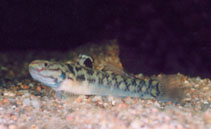|
Mugilogobius mertoni (Weber, 1911) Chequered mangrove goby |

|
|
photo by
Keith, P. |
| Family: | Gobiidae (Gobies), subfamily: Gobionellinae | |||
| Max. size: | 6 cm SL (male/unsexed) | |||
| Environment: | benthopelagic; freshwater; brackish; marine; depth range 0 - 5 m, amphidromous | |||
| Distribution: | Indo Pacific: from South Africa and Seychelles up to Japan, Pakistan, to the Indo-Malaysian archipelago, Papua-New Guinea, New Caledonia, Vanuatu, Australia and Santa Cruz Islands (Ref. 97791). | |||
| Diagnosis: |
Dorsal spines (total): 7-8; Dorsal soft rays (total): 6-8; Anal spines: 1-1; Anal soft rays: 6-8; Vertebrae: 25-27. Diagnosis: A moderate to large Mugilogobius with second dorsal and anal fin with 1 spine and 6-8 rays; pectoral fin rays 14-17; longitudinal scales 26-37; 12-16 circumpeduncular scales; predorsal scales 9-19, mostly small, central anteriormost scale immediately behind eyes always largest, anteriormost one to four scales larger than those posterior to them; scales on body mostly ctenoid; third spine of first dorsal fin most often longest; body brownish with 7-11 darker narrow diagonal bars, chevrons or X-shaped markings along sides, interspaces between chevrons or bars pale, forming chequered or banded pattern, two to three dark spots or short diagonal bars on caudal base (Ref. 43716). Description: Body relatively compressed, especially posteriorly; body depth at anal-fin origin 4.4-5.9 times in standard length; caudal peduncle compressed, its length 3.4-4.2 times in standard length, its depth 6.4-8.4 times in standard length (Ref. 43716). Head broad, rounded, wider than deep, head length 3.1-3.6 times in standard length; cheeks sometimes slightly inflated; mouth terminal to subterminal, slightly oblique, forming angle of about 20-25° with body axis; jaws generally reaching to below mid-eye, to posterior half of eye in large specimens, in males and to below anterior half of eye in females, to below mid-eye in large females; lips usually smooth, small fleshy fimbriae may be present on inner edges of upper lip; lower lip free at sides, fused narrowly across front; upper jaw 2.3-3.1 times in head length; eyes rather small, lateral, high on head, top usually forming part of dorsal profile; snout rounded; interorbital broad, flat; top of head from rear of interorbital space forward to snout tip covered with fine villi, usually visible in specimens with well-preserved mucous coat; scattered villi on preorbital and below eye in some specimens (Ref. 43716, 57749). Gill rakers on outer face of first arch 2+7 to 4+8 (Ref. 43716). First dorsal fin with 6-7 spines, low, rounded, tips of first three spines often free, with second or third often the longest ones, first spine sometimes longest and filamentous, spines always falling short of second dorsal fin origin when depressed, usually by gap of one scale width; second dorsal fin with 1 spine and 6-8 soft rays; anal fin with 1 spine and 6-8 soft rays; second dorsal and anal fins los, angled anteriorly, pointed posteriorly, posteriormost rays longest, rays falling well short of caudal fin when depressed; pectoral fin with 14-17 rays, rounded, central rays longest, 3.4-5.4 times in standard length, rays all branched but for uppermost; pelvic fins short, rounded to oval, reaching half to two-thirds distance to anus; caudal fin rounded; segmented caudal fin rays 15-17, caudal ray pattern modally 9/7; branched caudal fin rays 7/6 to 9/7; unsegmented caudal fin rays 5/6 to 7/7 (Ref. 43716, 57749). Scales in lateral series 26-37; scales in posterior transverse series 8-14; predorsal scales 9-19, small; circumpeduncular scales 12-16; cheeks naked, small scales on opercle; base of pectoral fins and prepelvic area show small cycloid scales; belly with ctenoid scales (Ref. 43716, 57749). Vertebrae 25-27; neural spines of first three, or first and second vertebra expanded or bifid at tip, or pointed and slender; 2 epurals; 1-3 anal pterygiophores before haemal spine of first caudal vertebra; metapterygoid wide, but not expanded upward greatly; forms broad bridge to quadrate (Ref. 43716). Colouration: Body brownish, grey-yellow to grey-violet with 7 to 11 dark diagonal stripes on the flanks; 2 to 3 black spots or short stripes at the base of the caudal; first dorsal with a black mark and a white stripe on its superior margin, base of the second dorsal sometimes with 1 or 2 raws of elongated grey or black marks; caudal and pelvic usually hyaline to greyish; one striking black mark at the base of the pectorals; head with several iregular red and blue stripes (Ref. 57749). |
|||
| Biology: | Mainly recorded from mangroves and estuaries, but also found in coastal freshwater streams (Ref. 43716). | |||
| IUCN Red List Status: | Least Concern (LC); Date assessed: 29 February 2020 Ref. (130435) | |||
| Threat to humans: | harmless | |||